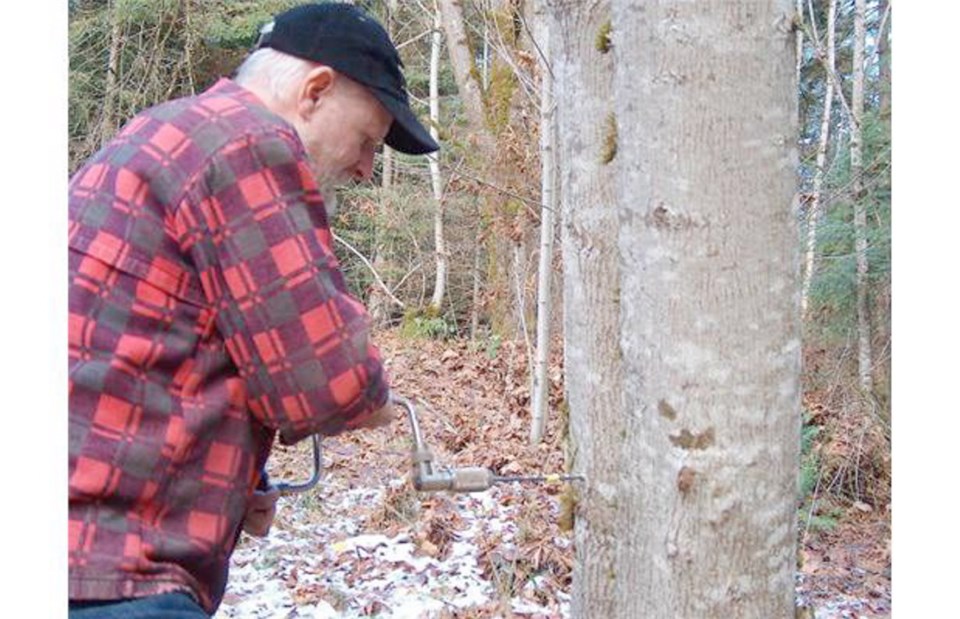It’s been a sour year for one of B.C.’s sweetest niche markets.
A dry fall and cold February contributed to one of the worst bigleaf maple syrup seasons in 10 years, said producer Gary Backlund.
A hot culinary trend, thanks in part to the 100-Mile diet, B.C.’s bigleaf maple syrup industry is largely based on Vancouver Island. Unlike the traditional maple syrup of Eastern Canada, which begins to flow in the spring, West Coast maple syrup is tapped whenever the weather warms after “mock winter events,” explained Backlund.
A cold spell followed by a short thaw in January led to some of the best-tasting syrup Backlund has produced, although February was a cold month with very little syrup to show.
For the first time, it was difficult to get a drip for the annual Bigleaf Maple Syrup Festival in Duncan, which attracts almost 2,000 people in early February.
By March, when the weather started to warm, the syrup was no longer palatable.
For Backlund and dozens of other B.C. farmers, syrup production is a “tasty sideline.”
“It really dovetails well with farming because there’s not a lot going on in winter, and you can get out there and tap the trees,” he said.
While the farmer is not dependent on maple syrup for his livelihood, he is one of a few dozen commercial producers enjoying the syrup’s popularity with local foodies.
“We sell out almost instantly,” he said of his Backlund’s Backwoods maple syrup.
Bigleaf maple syrup costs about $100 a litre and is used largely as a gourmet cooking product. The bigleaf maple is native to B.C. and is a different species than the sugar trees in Eastern Canada. Bigleaf maple syrup has a more butterscotch taste and intense flavour. It is also more concentrated than traditional maple syrup, with 50 litres of sap creating one litre of syrup (in traditional maple syrup 40 litres makes one litre).
Backlund began tapping trees 14 years ago when a forester introduced him to it.
“One taste and I was hooked,” he said. Backlund owns about 70 acres in Ladysmith with “a lot of maple trees on it.” Along with several others, he began to perfect production methods. A book he’s written on the subject has sold about 3,000 copies, and hundreds of people are tapping maple trees along the B.C. coast down to Oregon.
While bigleaf tapping is simply a hobby for many, Backlund sees a profitable future in its use in beer and wine — if only the weather would cooperate.
“That’s farming,” he said. “Some years are good and some are bad. We complain when it’s bad, but when it’s a good year we’re just smiling.”
.
Birch syrup in the Cariboo
B.C.’s other syrup industry is set to begin production soon. Birch syrup tapping will begin in the Cariboo in mid-April.
B.C. bigleaf maple syrup accounts for a small part of Canada’s total maple syrup production, which was valued at $117-million in 2006, according to Statistics Canada.
Nonetheless, the demand for B.C. syrup continues to grow.
BIGLEAF MAPLE
• Bigleaf maple is the most common maple on Vancouver Island and the largest maple in Canada, reaching heights of 36 metres.
• Top production season for bigleaf maple tapping is January and February.
• Ideal tapping conditions include a high water table and a few days of below-freezing temperature followed by a warm, sunny day to allow the sap to flow.
• Sap is made up of about 98 per cent water and 2 per cent sugar. It takes about 50 litres of sap to make one litre of syrup.
• The first Bigleaf Maple Syrup Festival was held on Vancouver Island in 2008.
• Traditionally, bigleaf sap was boiled into maple syrup by First Nations people, and the raw sap was used to treat scurvy and malnutrition.
BIRCH SYRUP
• Birch sap is very healthy and may contain minerals such as calcium, magnesium, potassium, zinc, iron, and vitamin A and has been consumed for centuries as a health drink in numerous countries
• In B.C., indigenous birch trees include White Birch, Paper Birch, Alaska Birch and Canoe Birch. Birch sap is primarily produced in the Cariboo region.
• A birch tree will produce an average of four litres of sap per tree per day over the season.
• Sap starts to flow once the ground thaws and temperatures are above freezing
• The production of birch syrup is very labour intensive. While traditional maple syrup takes approximately 40 litres of sap to produce one litre of syrup, it takes 80-120 litres of sap to produce the equivalent in birch syrup.
• Since birch syrup is predominantly fructose-based, it tastes less sweet and is reputed to easier to digest than maple syrup. Birch Syrup is typically used in cooking applications as opposed to pancake syrup.
— B.C. Ministry of Agriculture



